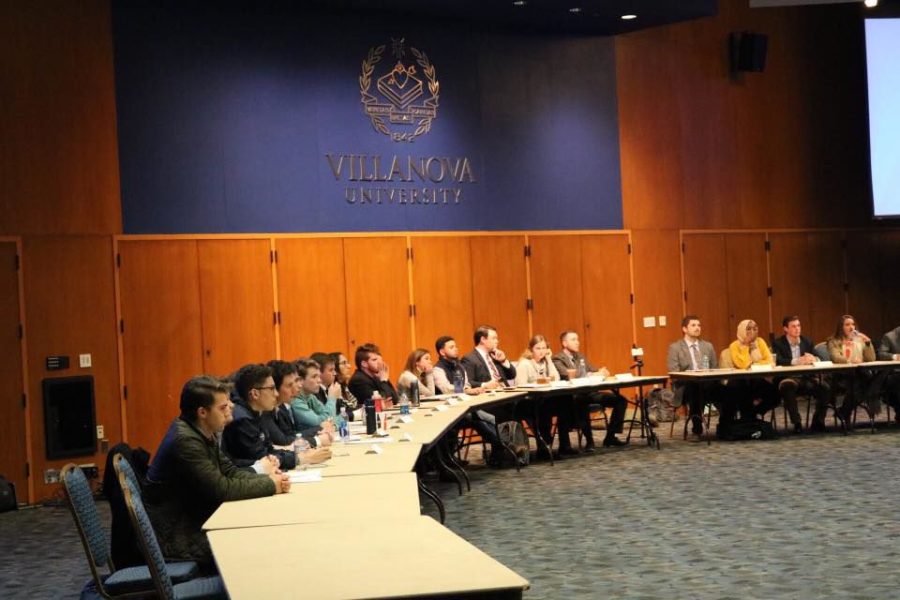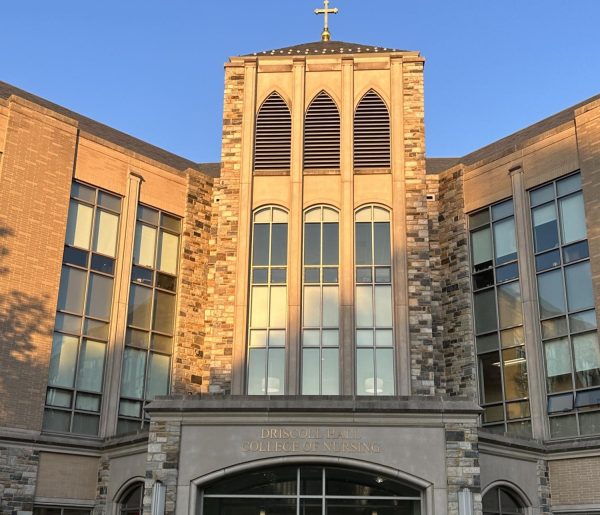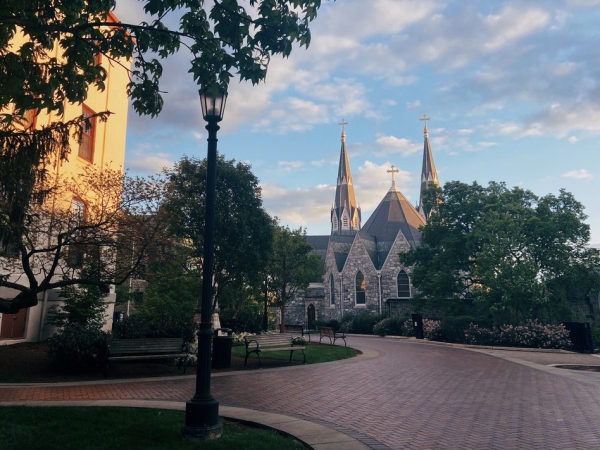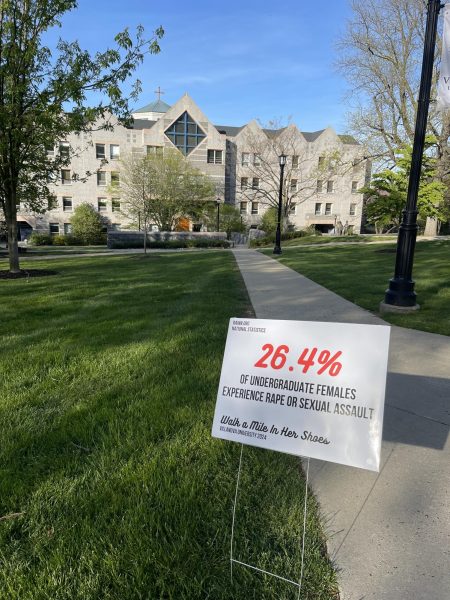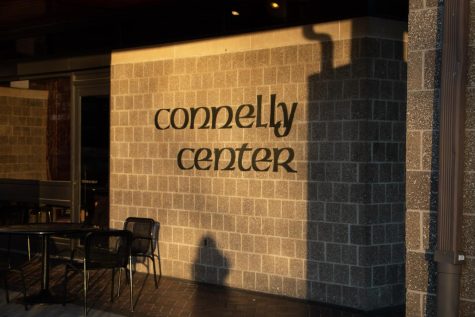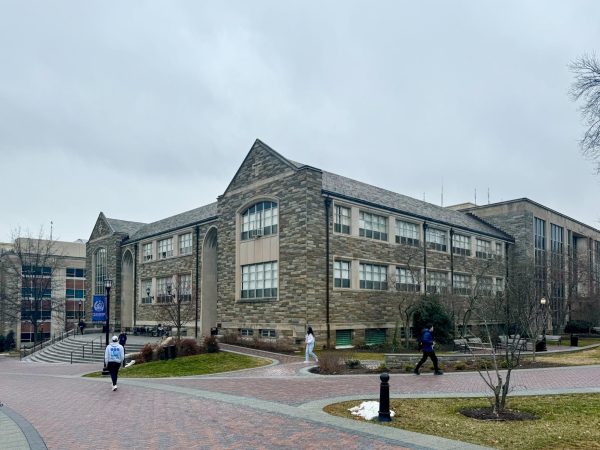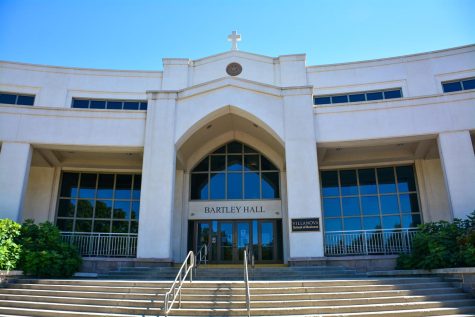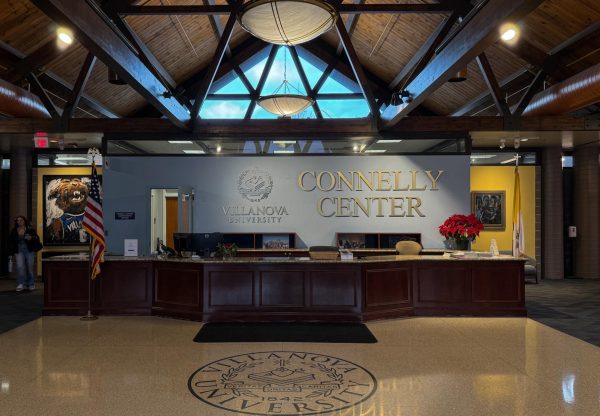SGA Highlights Importance of Safe Zones
February 13, 2018
On Wednesday, Jan. 31, the Villanova Student Government Association (SGA) held what was perhaps its most highly debated and anticipated meeting in recent memory. In fact, the expected turnout was so large that the meeting had to be held in the Connelly Center’s Villanova Room and even that filled beyond capacity.
That evening, there was a palpable energy and tension in the room, as a crowd of students and faculty gathered. Many were standing in the back of the room or sitting on any available floor space to watch a Senate debate and public forum concerning Villanova’s Safe Zone training and one senator’s refusal to partake in it.
The controversy that gave rise to this highly publicized meeting started when Senator Tim D’Agostino, a VSB sophomore, refused to participate in an SGA-mandated Safe Zone training session. The Safe Zone program, as explained by the University website, seeks to “provide safe spaces on campus that are highly visible and easily identifiable to all people as spaces where support and understanding are assured. By placing the Safe Zone symbol on their door, Safe Zone volunteers signify that within their space all people will be treated with dignity and respect regardless of race, ethnicity, national origin, gender, gender identity, gender expression, sexual orientation, class, religion, age or ability.”
Participation in this program, which many students and faculty members undergo, was required for all student government representatives by a piece of SGA legislation passed in Nov. of 2017. Despite such binding legislation, Senator D’Agostino chose not to participate in the training, citing a fundamental, ideological disagreement with the concept of a safe zone. In a statement read to fellow members of the SGA a week prior to this forum, Senator D’Agostino acknowledged that his actions— which he admittedly knew could result in his being divested of his Dean of the Senate leadership role— were prompted by his belief that safe zones on campus help students to “avoid reality” and hinder “diverse thinking” among students. Moreover, he likened the stand he took against on-campus safe zones to the stand Rosa Parks took against racial discrimination in segregationist America.
Senator D’Agostino’s statement and his self-comparison to Parks prompted great outcry from a number of student organizations and advocacy groups, such as the Association for Change & Transformation (ACT) and VU Pride. Meanwhile, the threat of D’Agostino’s removal from his Dean of the Senate position prompted outcry from members of Villanova College Republicans, as well as some of D’Agostino’s fellow fraternity brothers from the University’s Pi Kappa Phi chapter. Those opposed to D’Agostino’s removal organized a a protest of his removal before the SGA. In response, a group of students led by on-campus advocacy groups— who favored the Safe Zone program— staged a counter protest. The result was a public forum held
before the SGA in which concerned students from both camps could air their grievances and voice their opinions.
The forum featured testimony from dozens of students from both sides of the aisle (quite literally, as those in support of D’Agostino and those advocating for the Safe Zone program sat on opposite sides of the room).
Students in favor of the Safe Zone program were numerous and vocal. One Villanova student who serves as a Resident Assistant, who was required to go through the Safe Zone training as an R.A., explained that “safe zones” are “not a place where you hide from your problems, but get through the barriers from excelling in the community that you’re in.” That is, safe zones are intended to help students from various backgrounds and communities— particularly minority communities and those of underrepresented identities on the University campus— work through the unique challenges they face at the University.
Similar sentiments and personal experiences with the necessity of safe zones were expressed by other students, as well. One junior student recounted her experience with homophobic and threatening messages calling for the eradication of “the gays” being sent to her at 1:30 a.m., explaining that “until Villanova eradicates violence in all forms, safe zones are necessary to campus life.”
A number of students of color similarly recounted being called racial expletives and spat on by white students, further underscoring and elaborating on the need for such safe zones to foster an environment of respect and understanding on a campus that, as one student explained, is “not safe for people of certain identities.”
Thus, as yet another student explained, safe zones are “necessary to eliminate discrimination and bias” and help the University live up to the “values not always represented on campus that Villanova aspires to,” that is, values of “love, truth, and dialogue.”
Many of the students who spoke in favor of D’Agostino held the opposite view, that is, rather than promote open and honest dialogue, some students thought safe zones, as well as D’Agostino’s potential removal, would do just the opposite by promoting a single-minded and insular campus environment.
One member of Villanova College Republicans, for instance, claimed that D’Agostino’s removal represented the suppression of conservative voices on campus, as well as a “failure to listen to diverse ideologies,” while another claimed that forcing D’Agostino to act contrary to his will or be punished otherwise infringed on his freedom of expression.
In a similar vein, others speaking in support of D’Agostino continued to push the notion that, according to one sophomore student, “safe zones promote the idea that growth is bad… and hamper one’s ability to perform in the ‘real world.’”
Meanwhile, another member of Villanova College Republicans expressed the concern that while safe zones are important, forcing someone who does not believe in his or her purpose to partake in the program would essentially make the Safe Zone program “defunct.”
With these testimonies and statements in mind, the SGA then allowed Senator D’Agostino to speak once more, before moving to its own debate and vote of no confidence for D’Agostino as the Dean of Senate, which if passed would strip him of this leadership role.
In his final statement, D’Agostino explained that his “opposition is to safe zones, not to showing respect” for the diverse members of the Villanova community, while further expressing his belief that “respect is not a right but is earned.”
D’Agostino then went on to further clarify his belief fear that the supposedly insular “mentality” promoted by safe zones would make the University “more intolerant.”
Moreover, citing attacks on his character, D’Agostino asked not “to be seen first as a white male,” for he felt he was reduced to this identity despite being “much more than that.”
Additionally, he went on to address those who spoke in favor of safe zones, saying, “I am the reason you have all been given the chance to educate others on safe spaces.”
Following this statement, SGA moved to its debate. After much discussion and deliberation, the SGA voted by a 13-3 margin, with eight members abstaining, to remove D’Agostino from his role as Dean of the Senate.
Ultimately, as one SGA member explained, this decision was “not about [D’Agostino] or his beliefs, but about the legislation passed” and the SGA’s duty to “carry it out.”
Other members cited the “need to respect the rules [the SGA] puts in place,” explaining that since D’Agostino refused to respect such legislation, he necessarily could not carry out his role as the Dean of the Senate.

